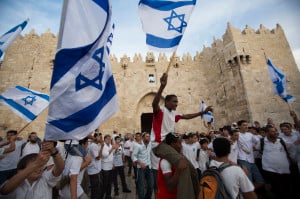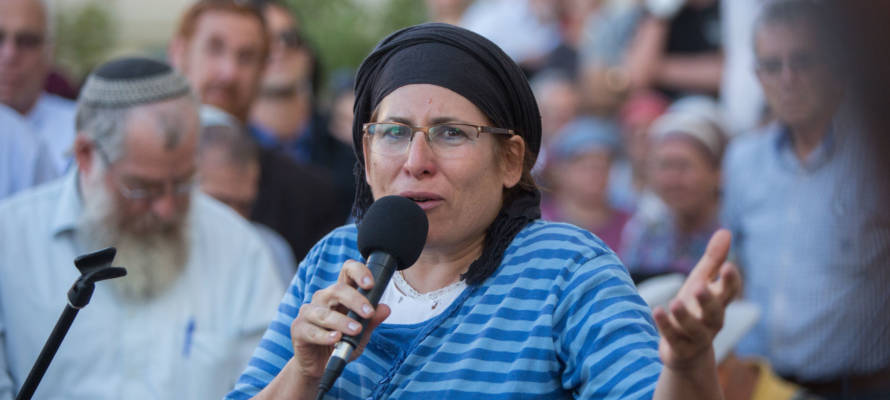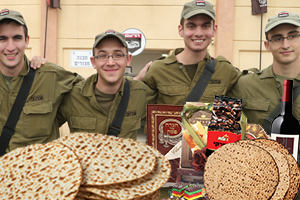
Rena Ariel refuses to succumb to terror. “When we wake up in the morning and find we have a mission to strengthen the Jewish people, this gives us a reason to keep going,” she says.
By: Atara Beck, United with Israel
Rena Ariel, mother of Hallel – a beautiful 13-year-old girl who was murdered by a teenage Palestinian terrorist last June while sleeping in her bed – is a true idealist. She has a mission in life and will not succumb to her grief.
Ariel lives in Kiryat Arba, a suburb of Hebron. She and her three sisters were among a small group of women who founded Nashim l’Ma’an Hamikdash – Women for the Holy Temple – 16 years ago. The organization works under an umbrella of groups, such as The Temple Institute, advocating for Jewish sovereignty at the Temple Mount in Jerusalem, renewing and strengthening the Jewish connection to the site and preparing for the building of the Third Temple.
The First Temple (c.1000-586 B.C.E.) and Second Temple (530 BCE-70 CE) were both destroyed on Tisha b’Av – the ninth day of the Hebrew month of Av – which falls this year on Friday night, August 12, lasting until sundown Saturday. (Observance is delayed a day because, according to Judaism, the Sabbath takes precedence.) The United with Israel (UWI) interview with Ariel about her Temple Mount activism, therefore, was especially timely.
Ariel and her husband Amihai, also a Temple Mount activist, have three other children; Hallel was the eldest.
Meeting at a café in Jerusalem, UWI asked Ariel how they manage to continue their hard work after such an unspeakable tragedy.
“When the terrorist murdered Hallel, he stabbed her in the heart,” she replied. “It wasn’t a coincidence. It was planned. He knew exactly what he was doing. He knew exactly what he was looking for. He wanted to destroy a family and to destroy the Jewish people. For us, when we wake up in the morning and find we have a mission to strengthen the Jewish people, this gives us a reason to keep going, knowing that they cannot win.”
Currently, Jews – as well as non-Muslims in general – experience profound discrimination when visiting their holiest site, although non-Jewish visitors manage much more easily. There are 11 entrances, and only one, Sha’ar Hamugrabi – recently renamed Sha’ar Hallel, after Ariel’s murdered daughter – may be used by non-Muslims.
Another project launched in memory of Hallel is the establishment of a visitors’ center in Kiryat Arba,to promote Jewish-Israeli identity, situated near the vineyard where her parents were working at the time of the stabbing.
‘Now is the Time’
Elaborating on her goals, Ariel, who was born in the U.S. and came to Israel as a child, said that “in this generation, it’s not enough to cry and mourn [over the exile and destruction of the Holy Temple], like the Jews did in the shtiebels [little houses or rooms for communal prayer in Jewish communities] 100 or 200 years ago. Now is the time to do something.”
According to Ariel, there’s a “buzz in the air, an understanding that something has to happen. In 1967 [in the Six Day War], Har Habayit [the Temple Mount] was liberated. It’s been almost 50 years, a generation and a half, but nothing has changed. It’s not just the government [that’s to blame]. As soon as the people wake up, we can begin to gain real sovereignty…
“The Jewish people have learned to live with the Beit Hamikdash as an eternal dream. We’re trying to bring it back to reality, not to let it remain abstract.”
The laws concerning the Holy Temple, which served as the center of Jewish religious life, are discussed in the Talmud. “We say we can build right now, not with bricks, but by preparing in order to be ready in every other sense,” by learning the intricate laws and by practicing, Ariel stressed.
“Kohanim [members of the priestly class] are practicing what to do,” she said. “We teach women to prepare the bread for the Temple offering according to Torah law, how to prepare the wine…”
Monthly events organized by the group are centered on the Jewish calendar. For example, before Chanukah they practice preparing the olive oil for the Temple. Even now, during the days leading to Tisha b’Av, they collect Tola’at HaShani (crimson worm) from oak trees. The tola’at was the source of the crimson dye used in biblical times to color the wool for the priests’ clothing and the Parochet (curtain for the Holy Ark) in the Mishkan (Tabernacle) and, later on, in the Temple.
“When Hallel was stabbed in the heart, the feeling was that the heart of the Jewish nation was stabbed,” Ariel stated. “The [Palestinian Arab] terrorist who came from a village not far from us was incited at Har Habayit, at the mosque where the imams preach hatred.”
“The situation in the world in general is that of a war between good and evil,” she said. “The whole world is getting hit by Islamic terrorism. The world has to decide whether it wants to be on the side of good or the side of evil…
“This is the center of the world. Whoever controls Har Habayit controls the situation. We believe that in the future, the Temple will be a place of peace,” a place of prayer for all nations, according to the prophecy of Isaiah. “Right now there is no peace, and it’s not because of the Jews.”

Sign the Declaration to Keep Jerusalem United
Jerusalem Must Remain the United Capital of Israel
I declare that Jerusalem is the eternal capital of the Jewish People and support all efforts to maintain and strengthen a united Jerusalem as the undivided capital of the State of Israel.
See our Privacy PolicySend Passover Packages to Needy Israeli Soldiers - Bring Them Joy!
We are honored to thank the young men and women of the IDF who risk their lives every day to protect the citizens of Israel. Since October 7th, soldiers have been on the battlefield for months - many are hoping to come home for Passover.
Join us in sending Passover food packages (and personal notes) to Israeli soldiers and their families.
Many soldiers spend the Passover holiday with needy families back home. The soldiers greatly appreciate your love and concern. Bring them Passover joy!
CLICK HERE TO SEND YOUR PACKAGE AND NOTE TO ISRAELI SOLDIERS!




